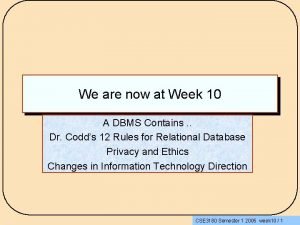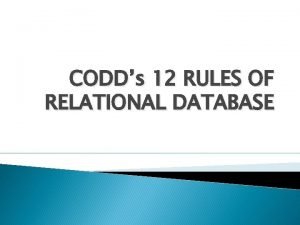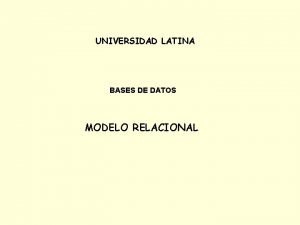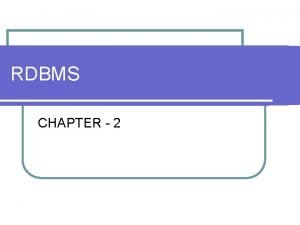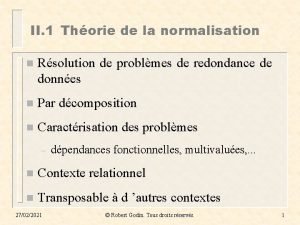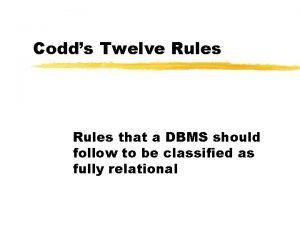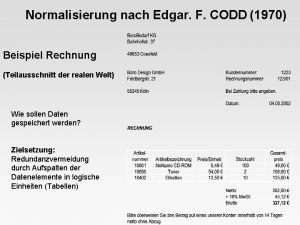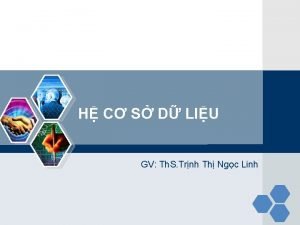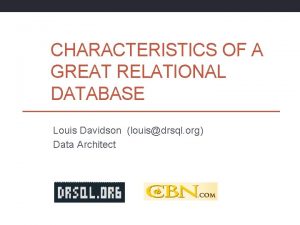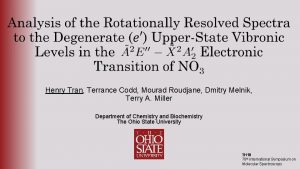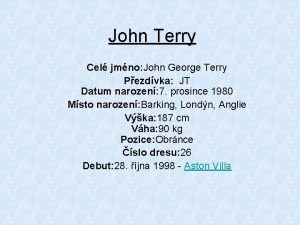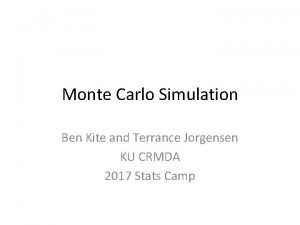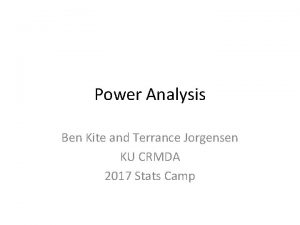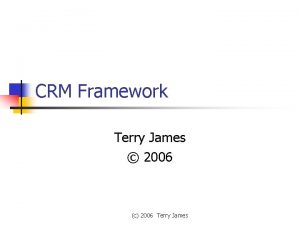Terrance J Codd John Stanton and Terry A


















- Slides: 18

Terrance J. Codd*, John Stanton†, and Terry A. Miller* * The Laser Spectroscopy Facility, Department of Chemistry and Biochem The Ohio State University, Columbus, Ohio † Department of Chemistry, The University of Texas at Austin, Tex

Previous Work � Hirota and colleagues reported observation of the 401 and 201 bands of the electronically forbidden transition a � First broad range spectrum was taken by Deev et al. in an ambient CRDS experimentb � Several bands were assigned in this work and evidence of strong JT coupling was reported � Jacox and Thompson recorded FTIR spectra of the transition in a Ne matrix experimentc � It significantly extended the spectral range and made several more assignments � They reported evidence of weak JT coupling in 4 � Most recently, Takematsu et al. have reported the observation of the vibronically forbidden origin of the and observed several hot bandsd transition � They refined the position of the origin band to 7062. 25 cm-1 and reported a second peak roughly 8 cm-1 to the blue a. K. Kawaguchi, T. Ishiwata, E. Hirota, I. Tanaka. Chem. Phys. 231, 193 (1998). E. Hirota, T. Ishiwata, K. Kawaguchi, M. Fujitake, N. Ohashi, I. Tanaka. J. Chem. Phys. 107, 2829 (1997) b. A. Deev, J. Sommar, M. Okumura. J. Chem. Phys, 122, 224305 (2005). c. M. E. Jacox, W. E. Thompson. J. Phys. Chem. A, 114, 4712 -4718 (2010). d. K. Takematsu, N. C. Eddingsaas, D. J. Robichaud, M. Okumura, Chem. Phys. Lett. , 555, 57 -63 (2013)

The “important” electronic states of NO 3 THE A-X ELECTRONIC SPECTRUM OF NO 3: SOME THEORETICAL RESULTS AND John F. Stanton and Christopher S. Simmons 66 th OSU International Symposium on Molecular Spectroscopy, TJ 03, Jun X 2 A 2′ A 2 Ea′′ A 2 Eb′′ B 2 Ea′ B 2 Eb′

The “important” electronic states of NO 3 THE A-X ELECTRONIC SPECTRUM OF NO 3: SOME THEORETICAL RESULTS AND I John F. Stanton and Christopher S. Simmons 66 th OSU International Symposium on Molecular Spectroscopy, TJ 03, June X 2 A 2′ A 2 Ea′′ A 2 Eb′′ JT A 2 Ea′′ JT 2 2 JT B 2 Ea′ B 2 Eb′ 3 , 4 X 2 A 2′ A 2 Eb′′ B 2 Ea′ JT A true multistate, multimode system with rich spectra and plenty of unsolved proble

NO 3 Vibronic Structure and Transitions Vibronically allowed transitions: (ground state) ≈≈ ≈ ≈

MR-JC-CRDS Experimental Setup 20 Hz, 8 ns, 500 m. J Nd: YAG pulse laser SRS (1 m, 18 atm H 2) 20 Hz, 8 ns, 100 m. J Sirah Dye Laser Filters Raman Cell 1 st or 2 nd Stokes 2 -10 m. J, Δν~3 GHz Ring-down cavity with slit-jet (absorption length ℓ = 5 cm) L = 67 cm PD In. Ga. As Detector 20 m Fiber Optic ℓ R ~ 99. 995 – 99. 999% @ 1. 3 mm Vacuum Pump Collimator

Room Temperature vs Jet-Cooled Spectra Room Temperature Jet Cooled 7500 7600 7700 7800 Room temperature data from: A. Deev, J. Sommar, M. Okumura. J. Chem. Phys, 122, 224305 (2005). 8100 wavenumber 8200 8300 8400

a. u. Jet-Cooled CRDS Data a. u. wavenumber (cm-1)

Vibronic Hamiltonian, , for Nuclear Motion on the Electronic Potential Energy Surface, V 3 D Plot of V showing Jahn-Teller Distortion

Quadratic Vibronic Hamiltonian Harmonic Oscillator Linear Jahn-Teller Quadratic Jahn-Teller Cross-Quadratic Jahn-Telle Bi-linear Coupling T. A. Barckholtz, T. A. Miller, Int Rev in Phys. Chem. 17, 435 -524 (1998)

Vibronic Parameters Hamiltonian Parameters Experimental Parameters

K 3, K 4 b 1, 3 b 1, 4 c 3, 4 K 3, K 4 b 1, 4 D 3 D 4 b 1, 3 c 3, 4 K 4 K 3, K 4 K 3

a. u. Vibronic Assignments a. u. wavenumber (cm-1)

Complementary of Parallel and Perpendicular Bands (41 vibronic levels x � (vibrational symmetry ≈ ) = 21 vibrational frequency ) ≈ ≈

a. u. Comparison of Observed and Simulated Line positions

a. u. Comparison of Observed and Simulated Line positions

Comparison of Observed and Calculated (John Stanton) Line Positions (Parallel Bands Only) Further work clearly needed

Conclusions • Over 20 Vibronic Bands in the Electronic Transition have been Observed and Assigned • The Structure of the State has been Well Stimulated Including Linear and Quadratic Vibronic Interaction Terms • Harmonic Frequencies for All 4 Vibrational Modes and Jahn. Teller Parameters for the e' Modes have been Obtained • More Detailed Comparison to Calculations Forthcoming Imminently
 Codd's 12 rules
Codd's 12 rules Boyce-codd normal form (bcnf) example
Boyce-codd normal form (bcnf) example Relational database rules
Relational database rules Bcnf
Bcnf Que es el modelo relacional en programacion
Que es el modelo relacional en programacion Ef codd rules
Ef codd rules Forme normale de boyce-codd
Forme normale de boyce-codd Codd's 12 rules
Codd's 12 rules Nick codd
Nick codd Atributos multivaluados
Atributos multivaluados Codd 1970
Codd 1970 Cho lược đồ quan hệ q(abcdegh)
Cho lược đồ quan hệ q(abcdegh) Louis davidson relational data modeling
Louis davidson relational data modeling What is the theme of barney by will stanton
What is the theme of barney by will stanton Marion stanton
Marion stanton Dr gregory stanton
Dr gregory stanton Dr gregory stanton
Dr gregory stanton Stanton chase
Stanton chase Influence graph
Influence graph
